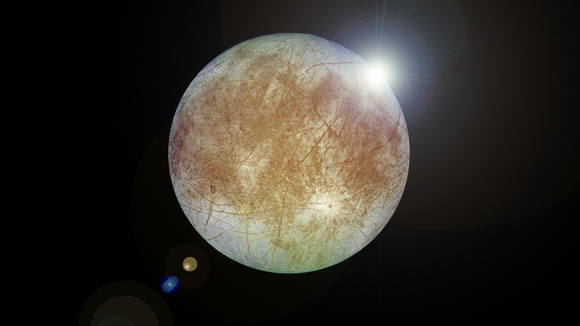Astronomers Observe Stellar Occultation by Jupiter’s Moon Europa | Astronomy – Sci-News.com
In March 2017, Brazilian National Observatory astronomer Bruno Morgado and colleagues took advantage of the beginning of the Jupiter passage through a very dense stellar region, with the center of the Milky Way as background, and organized an observational campaign to obtain data from a predicted stellar occultation by Jupiter’s icy moon Europa.

An artist’s impression of Jupiter’s moon Europa occulting a distant star. Image credit: NASA / JPL-Caltech / DLR / Sci-News.com.
A stellar occultation occurs when the light from a star is blocked by a foreground body — such as a planet, moon, ring, or asteroid — from reaching an observer.
The main reason for observing stellar occultations is that they can be used to probe ring systems and atmospheres in the outer Solar System.
Such measurements can be made from the ground — something that Dr. Morgado’s team took advantage of to explore Europa.
“We used data from the first data release of ESA’s Gaia mission to forecast that, from our viewpoint in South America, Europa would pass in front of a bright background star on March 31, 2017 — and to predict the best location from which to observe this occultation,” Dr. Morgado said.
“This gave us a wonderful opportunity to explore Europa, as the technique offers an accuracy comparable to that of images obtained by space probes.”
The Gaia data showed that the event would be visible from a thick band slicing from north-west to south-east across South America.
Three observatories located in Brazil and Chile were able to capture data — a total of eight sites attempted, but many experienced poor weather conditions.
The observations refined Europa’s radius to 970 miles (1561.2 km), precisely determined Europa’s position in space and in relation to Jupiter, and characterized the moon’s shape. Rather than being exactly spherical, Europa is known to be an ellipsoid.
“It’s likely that we’ll be able to observe far more occultations like this by Jupiter’s moons in 2019 and 2020,” Dr. Morgado said.
“Jupiter is passing through a patch of sky that has the Galactic center in the background, making it drastically more likely that its moons will pass in front of bright background stars. This would really help us to pin down their 3D shapes and positions — not only for Jupiter’s four largest moons, but for smaller, more irregularly-shaped ones, too.”
Using Gaia’s second data release, provided in April 2018, the astronomers predict the dates of further occultations of bright stars by Europa, Io, Ganymede and Callisto in coming years, and list a total of 10 events through 2019 and 2021.
Future events comprise stellar occultations by Europa (June 22, 2020), Callisto (June 20, 2020; May 4, 2021), Io (September 9 and 21, 2019; April 2, 2021), and Ganymede (April 25, 2021).
The upcoming occultations will be observable even with amateur telescopes from various regions around the world.
The favorable position of Jupiter, with the Galactic plane in the background, will only occur again in 2031.
“Stellar occultation studies allow us to learn about moons in the Solar System from afar, and are also relevant for future missions that will visit these worlds,” said Dr. Timo Prusti, Gaia project scientist.
“As this result shows, Gaia is a hugely versatile mission: it not only advances our knowledge of stars, but also of the Solar System more widely.”
The team’s work was published in the journal Astronomy & Astrophysics.
_____
B. Morgado et al. 2019. First stellar occultation by the Galilean moon Europa and upcoming events between 2019 and 2021. A&A 626, L4; doi: 10.1051/0004-6361/201935500





